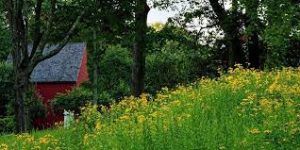6 Hidden Art Historical Gems, Including Weir Farm National Historic Site, Wilton, Connecticut
 When New York City collector Erwin Davis became obsessed with a painting owned by artist Julian Alden Weir, he gave him an offer that was hard to refuse. In exchange for the painting and ten dollars, Davis would transfer over the deed to a 153-acre farm less than an hour outside of New York in the Connecticut countryside. Weir arrived in the summer of 1882, immediately became enamored with the sylvan setting, and painted the first of hundreds of works he and his friends would create over the next 40 years. To this day, the property remains a rural retreat that continues to inspire artists and is now the only site in the National Park System dedicated to American painting. Walk inside the Visitor Center to see a short film on the life J. Alden Weir, considered one of the fathers of American Impressionism. That’s not to say he wasn’t disgusted with this style of painting when he first encountered it in Paris, calling an exhibition showcasing the works of Monet, Manet, and Degas “worse than the Chamber of Horrors.” Yet, soon enough, Weir was utilizing the loose brushstrokes and plein air painting that would become the trademarks of Impressionism.
When New York City collector Erwin Davis became obsessed with a painting owned by artist Julian Alden Weir, he gave him an offer that was hard to refuse. In exchange for the painting and ten dollars, Davis would transfer over the deed to a 153-acre farm less than an hour outside of New York in the Connecticut countryside. Weir arrived in the summer of 1882, immediately became enamored with the sylvan setting, and painted the first of hundreds of works he and his friends would create over the next 40 years. To this day, the property remains a rural retreat that continues to inspire artists and is now the only site in the National Park System dedicated to American painting. Walk inside the Visitor Center to see a short film on the life J. Alden Weir, considered one of the fathers of American Impressionism. That’s not to say he wasn’t disgusted with this style of painting when he first encountered it in Paris, calling an exhibition showcasing the works of Monet, Manet, and Degas “worse than the Chamber of Horrors.” Yet, soon enough, Weir was utilizing the loose brushstrokes and plein air painting that would become the trademarks of Impressionism.
View the wonderful photographs of Weir with John Singer Sargent and Childe Hassam, two of the celebrated artists that enjoyed visiting Weir at his country home, and see the lone original work in the building, The Truants (1895). Then immerse yourself in the same natural setting that inspired Weir. Trails lead to a pond, barns, old stone walls, a sunken garden, and his house and studio. Better yet, bring a sketchbook.
This entry is excerpted from my latest book, New England in a Nutshell. The book/ebook is slated to published on July 2nd and you can pre-order now at Amazon. The ebook includes all hyperlinks to listings. The paperback includes front and back cover illustrations from Manhattan-based artist, Sarah Schechter, and a small sampling of photos from Lisa, who accompanied me on many of my assignments, resulting in published work for the Boston Globe.
